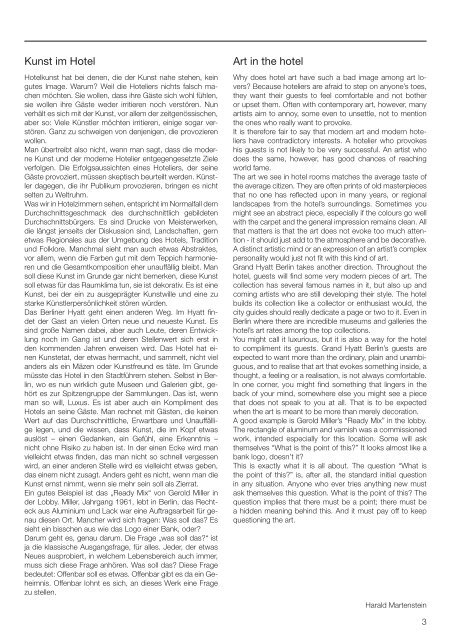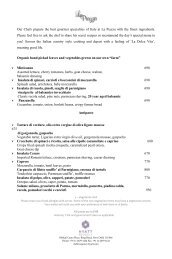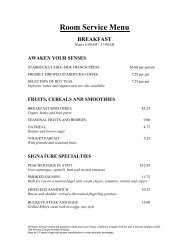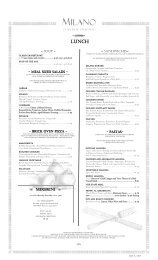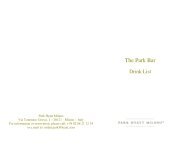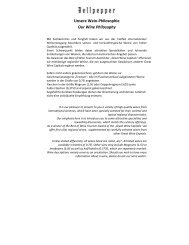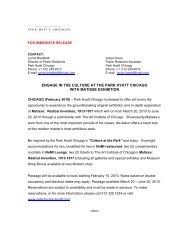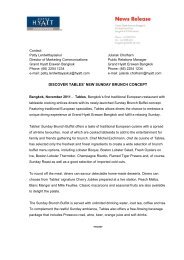KUNST IM GRAND HYATT BERLIN - Hyatt Hotels and Resorts
KUNST IM GRAND HYATT BERLIN - Hyatt Hotels and Resorts
KUNST IM GRAND HYATT BERLIN - Hyatt Hotels and Resorts
Erfolgreiche ePaper selbst erstellen
Machen Sie aus Ihren PDF Publikationen ein blätterbares Flipbook mit unserer einzigartigen Google optimierten e-Paper Software.
Kunst im Hotel<br />
Hotelkunst hat bei denen, die der Kunst nahe stehen, kein<br />
gutes Image. Warum? Weil die Hoteliers nichts falsch machen<br />
möchten. Sie wollen, dass ihre Gäste sich wohl fühlen,<br />
sie wollen ihre Gäste weder irritieren noch verstören. Nun<br />
verhält es sich mit der Kunst, vor allem der zeitgenössischen,<br />
aber so: Viele Künstler möchten irritieren, einige sogar verstören.<br />
Ganz zu schweigen von denjenigen, die provozieren<br />
wollen.<br />
Man übertreibt also nicht, wenn man sagt, dass die moderne<br />
Kunst und der moderne Hotelier entgegengesetzte Ziele<br />
verfolgen. Die Erfolgsaussichten eines Hoteliers, der seine<br />
Gäste provoziert, müssen skeptisch beurteilt werden. Künstler<br />
dagegen, die ihr Publikum provozieren, bringen es nicht<br />
selten zu Weltruhm.<br />
Was wir in Hotelzimmern sehen, entspricht im Normalfall dem<br />
Durchschnittsgeschmack des durchschnittlich gebildeten<br />
Durchschnittsbürgers. Es sind Drucke von Meisterwerken,<br />
die längst jenseits der Diskussion sind, L<strong>and</strong>schaften, gern<br />
etwas Regionales aus der Umgebung des <strong>Hotels</strong>, Tradition<br />
und Folklore. Manchmal sieht man auch etwas Abstraktes,<br />
vor allem, wenn die Farben gut mit dem Teppich harmonieren<br />
und die Gesamtkomposition eher unauffällig bleibt. Man<br />
soll diese Kunst im Grunde gar nicht bemerken, diese Kunst<br />
soll etwas für das Raumklima tun, sie ist dekorativ. Es ist eine<br />
Kunst, bei der ein zu ausgeprägter Kunstwille und eine zu<br />
starke Künstlerpersönlichkeit stören würden.<br />
Das Berliner <strong>Hyatt</strong> geht einen <strong>and</strong>eren Weg. Im <strong>Hyatt</strong> findet<br />
der Gast an vielen Orten neue und neueste Kunst. Es<br />
sind große Namen dabei, aber auch Leute, deren Entwicklung<br />
noch im Gang ist und deren Stellenwert sich erst in<br />
den kommenden Jahren erweisen wird. Das Hotel hat einen<br />
Kunstetat, der etwas hermacht, und sammelt, nicht viel<br />
<strong>and</strong>ers als ein Mäzen oder Kunstfreund es täte. Im Grunde<br />
müsste das Hotel in den Stadtführern stehen. Selbst in Berlin,<br />
wo es nun wirklich gute Museen und Galerien gibt, gehört<br />
es zur Spitzengruppe der Sammlungen. Das ist, wenn<br />
man so will, Luxus. Es ist aber auch ein Kompliment des<br />
<strong>Hotels</strong> an seine Gäste. Man rechnet mit Gästen, die keinen<br />
Wert auf das Durchschnittliche, Erwartbare und Unauffällige<br />
legen, und die wissen, dass Kunst, die im Kopf etwas<br />
auslöst – einen Gedanken, ein Gefühl, eine Erkenntnis –<br />
nicht ohne Risiko zu haben ist. In der einen Ecke wird man<br />
vielleicht etwas finden, das man nicht so schnell vergessen<br />
wird, an einer <strong>and</strong>eren Stelle wird es vielleicht etwas geben,<br />
das einem nicht zusagt. Anders geht es nicht, wenn man die<br />
Kunst ernst nimmt, wenn sie mehr sein soll als Zierrat.<br />
Ein gutes Beispiel ist das „Ready Mix“ von Gerold Miller in<br />
der Lobby. Miller, Jahrgang 1961, lebt in Berlin, das Rechteck<br />
aus Aluminium und Lack war eine Auftragsarbeit für genau<br />
diesen Ort. Mancher wird sich fragen: Was soll das? Es<br />
sieht ein bisschen aus wie das Logo einer Bank, oder?<br />
Darum geht es, genau darum. Die Frage „was soll das?“ ist<br />
ja die klassische Ausgangsfrage, für alles. Jeder, der etwas<br />
Neues ausprobiert, in welchem Lebensbereich auch immer,<br />
muss sich diese Frage anhören. Was soll das? Diese Frage<br />
bedeutet: Offenbar soll es etwas. Offenbar gibt es da ein Geheimnis.<br />
Offenbar lohnt es sich, an dieses Werk eine Frage<br />
zu stellen.<br />
Art in the hotel<br />
Why does hotel art have such a bad image among art lovers?<br />
Because hoteliers are afraid to step on anyone’s toes,<br />
they want their guests to feel comfortable <strong>and</strong> not bother<br />
or upset them. Often with contemporary art, however, many<br />
artists aim to annoy, some even to unsettle, not to mention<br />
the ones who really want to provoke.<br />
It is therefore fair to say that modern art <strong>and</strong> modern hoteliers<br />
have contradictory interests. A hotelier who provokes<br />
his guests is not likely to be very successful. An artist who<br />
does the same, however, has good chances of reaching<br />
world fame.<br />
The art we see in hotel rooms matches the average taste of<br />
the average citizen. They are often prints of old masterpieces<br />
that no one has reflected upon in many years, or regional<br />
l<strong>and</strong>scapes from the hotel’s surroundings. Sometimes you<br />
might see an abstract piece, especially if the colours go well<br />
with the carpet <strong>and</strong> the general impression remains clean. All<br />
that matters is that the art does not evoke too much attention<br />
- it should just add to the atmosphere <strong>and</strong> be decorative.<br />
A distinct artistic mind or an expression of an artist’s complex<br />
personality would just not fit with this kind of art.<br />
Gr<strong>and</strong> <strong>Hyatt</strong> Berlin takes another direction. Throughout the<br />
hotel, guests will find some very modern pieces of art. The<br />
collection has several famous names in it, but also up <strong>and</strong><br />
coming artists who are still developing their style. The hotel<br />
builds its collection like a collector or enthusiast would, the<br />
city guides should really dedicate a page or two to it. Even in<br />
Berlin where there are incredible museums <strong>and</strong> galleries the<br />
hotel’s art rates among the top collections.<br />
You might call it luxurious, but it is also a way for the hotel<br />
to compliment its guests. Gr<strong>and</strong> <strong>Hyatt</strong> Berlin’s guests are<br />
expected to want more than the ordinary, plain <strong>and</strong> unambiguous,<br />
<strong>and</strong> to realise that art that evokes something inside, a<br />
thought, a feeling or a realisation, is not always comfortable.<br />
In one corner, you might find something that lingers in the<br />
back of your mind, somewhere else you might see a piece<br />
that does not speak to you at all. That is to be expected<br />
when the art is meant to be more than merely decoration.<br />
A good example is Gerold Miller’s “Ready Mix” in the lobby.<br />
The rectangle of aluminum <strong>and</strong> varnish was a commissioned<br />
work, intended especially for this location. Some will ask<br />
themselves “What is the point of this?” It looks almost like a<br />
bank logo, doesn’t it?<br />
This is exactly what it is all about. The question “What is<br />
the point of this?” is, after all, the st<strong>and</strong>ard initial question<br />
in any situation. Anyone who ever tries anything new must<br />
ask themselves this question. What is the point of this? The<br />
question implies that there must be a point; there must be<br />
a hidden meaning behind this. And it must pay off to keep<br />
questioning the art.<br />
Harald Martenstein<br />
3


